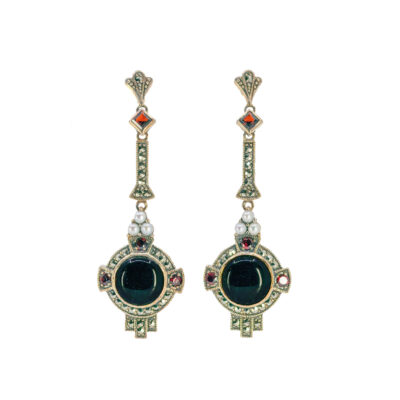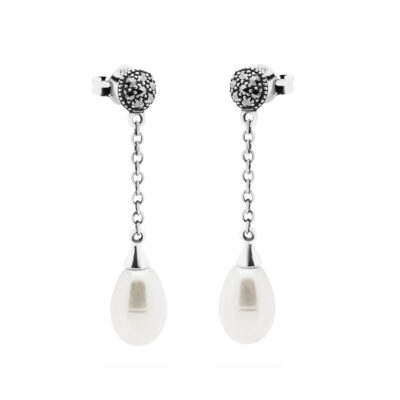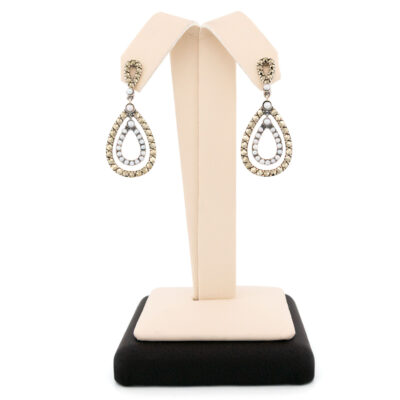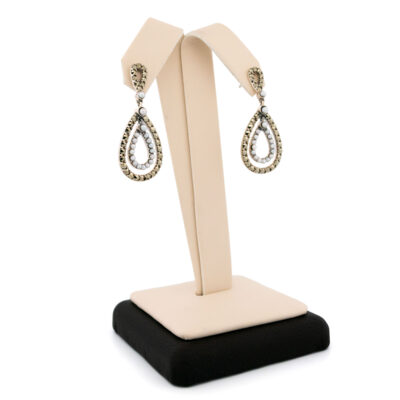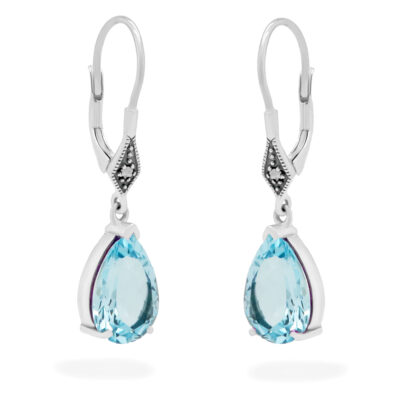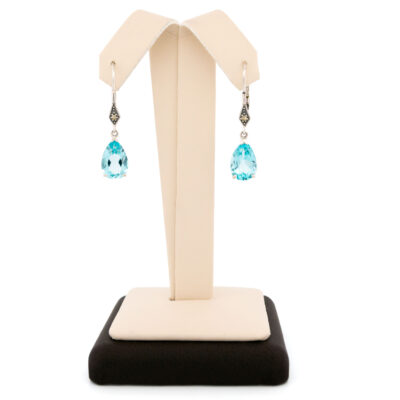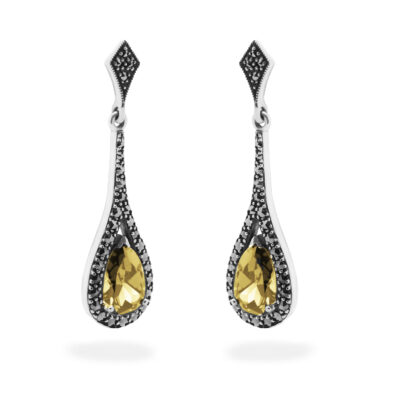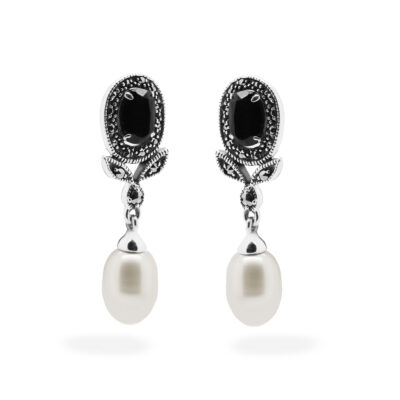Refined yet striking, these drop earrings feature radiant 6mm freshwater pearls gracefully suspended from a line of shimmering marcasites. Crafted in sterling silver with intricate detailing, they blend classic beauty with a contemporary flair. A perfect choice for understated elegance. ✨
Details: 6mm FW Pearls, Marcasites (pyrite), Silver Earrings.
Design Era: Contemporary.
Weight in grams: 3.
Condition: New.
Shipping and Pickup: This lovely piece ships from our store located in the center of Amsterdam, The Netherlands. We offer both registered shipping and local pickup at our store. In the case of local pickup, any applicable shipping costs will be refunded.
About Us: Add some sparkle to your style with Binenbaum.com. We offer a stunning selection of antique and vintage jewelry that you won’t find anywhere else. From timeless rings and dazzling necklaces to unique brooches, we have something for every taste and occasion. Visit our website today and treat yourself to a piece of history.
| Design Era | |
|---|---|
| Design & Historical Context | Contemporary jewellery is a type of jewellery that reflects current trends and styles, and is often made from a variety of materials beyond the traditional precious metals and stones. This allows contemporary jewellery to have a more modern and unique appearance compared to classic jewellery. To create contemporary jewellery, it is necessary to have both specialized training and a deep understanding of the subject. The contemporary style combines historical techniques and artistic expression with innovative ideas and materials, giving it a distinct personality that falls between fashionable mass-produced jewellery and traditional artisanal works of art. |
| Key Materials | |
| Materials & Craftsmanship | Pearl: The Gem of Elegance and Purity Pearls, with their natural luster and timeless beauty, are one of the most revered gemstones in the world. Unlike other gems, pearls are organic, formed within the soft tissue of mollusks like oysters and mussels. Their formation process results in a smooth, round gem with a soft, iridescent glow, often referred to as the "pearl essence." Historically, pearls have been a symbol of purity, wisdom, and wealth. In ancient Rome, they were considered the ultimate status symbol, while in ancient China, pearls were believed to protect against fire and dragons. During the Renaissance, pearls were so highly valued that they were reserved for royalty and nobility, symbolizing perfection and integrity. In modern jewelry, pearls are cherished for their classic elegance and versatility. They are commonly found in a range of colors, from the traditional white and cream to rare black, pink, and golden hues. Pearls are often strung into necklaces, set into earrings, or used as delicate accents in rings and bracelets. Their softness, with a Mohs hardness of 2.5 to 4.5, requires gentle care, but their beauty and sophistication are unmatched. Pearls are more than just a gem; they are a symbol of grace, purity, and timeless style. Their natural origins and understated elegance make them a beloved choice for jewelry that exudes refinement and sophistication. Marcasite (pyrite): The Gem of Timeless Elegance and Vintage Charm Marcasite, often mistakenly referred to as pyrite, is a gemstone that has captivated jewelry enthusiasts for centuries with its metallic luster and vintage appeal. Although marcasite is technically a form of pyrite, true marcasite jewelry is made from pyrite crystals that are cut and polished to create a shimmering, antique look. Historically, marcasite has been admired for its mysterious, reflective surface, often used in intricate, filigree designs during the Victorian and Art Deco periods. In the 18th and 19th centuries, it became particularly popular in Europe as a more affordable alternative to diamonds, lending an air of elegance and sophistication to brooches, rings, and other accessories. In modern jewelry, marcasite is prized for its ability to add a touch of vintage charm and drama to any piece. Its metallic, gunmetal-gray hue pairs beautifully with silver settings, and its natural sparkle makes it a standout in both understated and ornate designs. Marcasite is commonly seen in rings, earrings, pendants, and brooches, often set in sterling silver to enhance its classic, antique look. Marcasite is more than just a gemstone; it is a symbol of timeless elegance and enduring style. Its historical significance and unique, reflective quality make it a cherished choice for jewelry that exudes both character and sophistication, perfect for those who appreciate the charm of vintage-inspired designs. Silver: The Metal of Elegance and Versatility Silver, known for its bright, reflective luster, is one of the most beloved and widely used precious metals in the world. This versatile metal has been cherished for thousands of years, not only for its beauty but also for its malleability, making it ideal for crafting intricate and delicate jewelry designs. Historically, silver has been associated with the moon and considered a symbol of purity, clarity, and protection. Ancient civilizations, from the Egyptians to the Greeks and Romans, valued silver for its beauty and used it to create coins, jewelry, and religious artifacts. In many cultures, silver is also believed to have healing properties, often used in amulets and talismans to ward off negative energy. In modern jewelry, silver is prized for its affordability, versatility, and timeless appeal. Sterling silver, an alloy of 92.5% pure silver and 7.5% other metals (usually copper), is the standard used in high-quality jewelry. Its durability and bright, reflective surface make it an excellent choice for a wide range of designs, from minimalist pieces to ornate creations. Silver can be polished to a high shine or given a matte, oxidized, or antiqued finish to suit various styles. Silver is more than just a metal; it is a symbol of elegance, flexibility, and understated luxury. Its enduring popularity and wide-ranging applications make it a staple in jewelry that can complement any look, from casual to formal, with timeless grace. |
| Gender | |
| Weight (in grams) | 3 |
| Condition |
By following these tips, you can enjoy your precious jewelry for many years to come.
Related Products
-
Garnet Marcasite (Pyrite) Onyx Pearl Silver Drop Earrings 15395-2145
€ 375,00 VAT incl. (where applicable) -
Marcasite (Pyrite) Pearl Silver Drop Earrings 14960-1946
€ 115,00 VAT incl. (where applicable) -
Marcasite (Pyrite) Pearl Silver Drop Earrings 14857-1932
€ 165,00 VAT incl. (where applicable) -
Marcasite (Pyrite) Pearl Silver Drop Earrings 14157-1492
€ 265,00 VAT incl. (where applicable) -
Marcasite (Pyrite) Topaz Silver Drop Earrings 16957-2791
€ 175,00 VAT incl. (where applicable) -
Citrine Marcasite (Pyrite) Silver Drop Earrings 16959-2794
€ 175,00 VAT incl. (where applicable) -
Marcasite (Pyrite) Onyx Pearl Silver Earrings 16442-2590
€ 145,00 VAT incl. (where applicable) -
Marcasite (Pyrite) Pearl Silver Cluster Earrings 15698-2281
€ 165,00 VAT incl. (where applicable)
- Home
- Collection
- Fine Jewelry
- Silver Jewelry
- Silverware
- Boxes
- Candlesticks
- Salt and pepper shakers
- Miniatures
- Salt cellars
- Spoon Set
- Condiments
- Frames
- Napkin Ring
- Spoon
- Oddities
- Cups
- Vases
- Cutlery
- Serving Spoon And Cake Server
- Candlesticks
- Baskets
- Hanukkiah
- Spice Tower
- Yad
- Tea Set
- Sugar Castor
- Napkin Rings
- Wine Bottle Coaster
- Wine Stopper
- Tea Pot
- Jugs
- Rattles
- Hip Flask
- Miscellaneous
- Rings 💍
- About
- Contact

